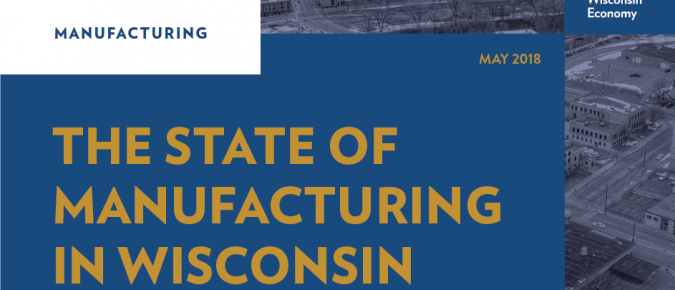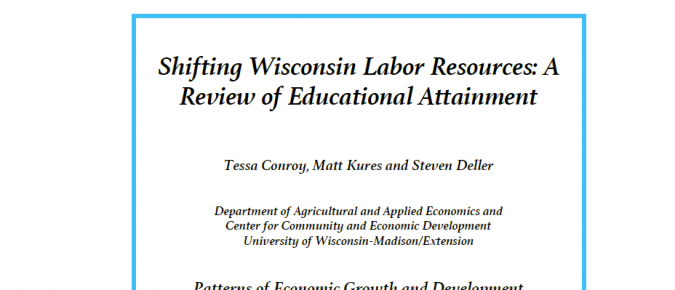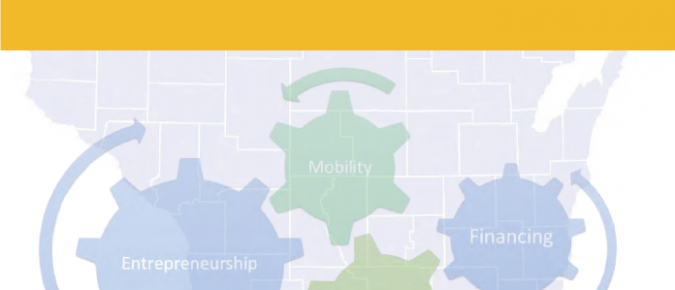For the updated Trade Area Analysis (TAA) of Wisconsin counties we use the sales tax data as reported by the Wisconsin Department of Revenue for 2017. Only those counties that have elected to collect the optional county sales tax are included in the analysis. Because sales tax data are used one must keep in mind that the analysis focuses only on taxable sales and may not reflect the total level of activity in the county. Using Pull Factors and measures of Surplus and Leakage, the relative strengths and weaknesses of local retail markets are identified. An example of how to explore changes in Pull Factors over time to identify strengths, weaknesses, opportunities and potential threats is also provided.
July 2019 — Patterns of uneven economic growth and development across the U.S. have been well established in the popular press and academic literature. Some states, such as Mississippi, Alabama and New Mexico, continue to experience higher rates of poverty, lower rates of worker productivity, and modest income growth. Other states, such as Arizona, Colorado […]
June 2019 — Much attention has been paid to the role of entrepreneurship as a source of job creation in recent years. While this is warranted, expansions of existing businesses are also inseparable from job creation and economic growth. In terms of gross job creation, firm expansions contribute a significantly higher number of jobs than […]
EXECUTIVE SUMMARY May 2019 — The following analysis explores the status of manufacturing in Wisconsin by examining long term trends and benchmarking against comparable states in the Midwest region and the U.S. more generally. Key Findings: Despite fluctuations, the recent number of manufacturing jobs in Wisconsin is close to the level in 1970 at 500,000. […]
February 2019 — The relationship between the diversity of a regional economy and economic growth, stability, and resiliency has been at the center of a large academic literature for over 70 years. Drawing on the idea that a diversified portfolio of investments (e.g. stocks, bonds, etc.) can minimize risk and foster sustainable returns (growth) many […]
December 2018 — With unemployment rates at historical lows and many employers having difficulty finding workers to fill their open positions, policymakers and employers alike are looking for available labor. In Wisconsin, the labor force participation rate is already well above the national average. Given the age structure and historical trends identified by Kures, Deller, […]
EXECUTIVE SUMMARY November 2018 — If the vision for Wisconsin’s future economy is one of competitive wages, innovative industry, and an entrepreneurial culture, then there are challenges on the horizon. From the perspective of developing an educated labor force that supports both innovation and entrepreneurship, the metrics presented in this report are troubling. The education […]
October 2018 — The importance of small business development and entrepreneurship to the future health of the economy is becoming more widely understood and accepted across Wisconsin. Wisconsin focused research (Conroy and Deller 2015a) has documented that nearly all of the net job growth (expansions minus contractions) comes from start-up businesses, which tend to be […]
EXECUTIVE SUMMARY August 2018 — The analysis presented in this report uses two types of comparisons to evaluate job creation and job loss in Wisconsin. First, we consider trends over time by comparing the most recent years available, 2012 or 2013 depending on the data source, with 2000 and 2009. The year 2000 is useful […]
EXECUTIVE SUMMARY August 2018 — For updated Trade Area Analysis (TAA) of Wisconsin counties we use the sales tax data as reported by the Wisconsin Department of Revenue for 2017. Only those counties that have elected to collect the optional county sales tax are included in the analysis. Because sales tax data are used one […]
July 2018 — As Wisconsin’s unemployment rate moves to record lows, many companies have expressed frustration that they cannot find the workers they need. Some employers, workforce development organizations and policy makers attribute the lack of suitable employees to issues surrounding labor quality. Specifically, potential workers may not have the specific skills desired by employees […]
EXECUTIVE SUMMARY July 2018 — Since the start of the Great Recession, the death rate of Wisconsin businesses with employees (i.e. employer businesses) has outpaced the startup rate. As a result, after almost three decades of growth, the number of businesses with employees in Wisconsin started to decline in 2007.New employer businesses are a critical […]
















